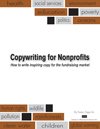Two recent posts from friends and colleagues cover two critical view points or strategies. I’ll hit the highlights here but I urge you to read the full post on each of their blogs.
1 – Your nonprofit website and branding
By Sarah Durham in The Duck Call
One of the main points Sarah made in her post is something I see over, and over, and over again.
People get swayed by design and focus too much on the glitz. Too many graphics; graphics and photos that are so large you have to scroll before you find anything to read; bright colors everywhere; etc.
There’s so much competing for your eye’s attention that the viewer gets “lost.”
When everyone is shouting in a room … no one gets heard. You can’t concentrate or understand any single message.
Likewise, when everything is bold and large on your website … nothing gets seen. The viewer can’t concentrate or understand what is most important. They don’t know where to begin. And if they can’t figure it out within a couple seconds, there’s an incredibly HIGH probability that they’ll leave.
In Sarah’s words: “While most people tend to think ‘logo’ or even ‘visuals’ when they hear the word ‘brand’, we Ducks argue that messaging is just as important. And clear messaging should be the backbone of your website.”
If you want your website to persuade … if you want it to be sticky … then you must concentrate on giving the words priority. The text, the copy – this is what persuades. That’s not only the opinion of Karen Zapp the copywriter. That’s a proven fact based on extensive testing by companies and marketers in countless industries, including the nonprofit sector.
Read everything Sarah has to say on the subject in her post titled, “Why you shouldn’t rebrand as you build that new website”
That’s the “what to say” of my post. Now let’s touch on “how often to say it.”
2 – Fewer communications with donors can be deadly
By Jeff Brooks in Future Fundraising Now
Ever get a note or call from a donor that says, “I only want to hear from you once a year.” Or maybe it’s something like, “No wonder you’re struggling to raise money when you send me a letter every month!”
You receive a mere handful of these messages. But based on the few, someone in your nonprofit makes a wholesale decision that is applied to your entire file: They reduce the number of mailings.
Jeff refers to this as the “most deadly – and most common – error in fundraising.”
Or maybe you don’t receive any messages but you just start to worry. Or you’re trying to cut the budget. Whatever drives the decision someone changes the plan because they believe . . .
Donors don’t want to hear from us very often. Too much content (i.e., direct mail letters, newsletters, email, or whatever sent too frequently), drives donors away. This excess content is eroding our donor file.
WRONG! That way of thinking and acting is almost certain to cost your nonprofit dearly. As Jeff says:
“There’s no evidence that it’s true. In fact, the evidence shows us that decreasing donor contact almost always leads to less revenue. Worse yet, it leads to lower donor retention.
In other words, you’re a lot more likely to drive away donors by not communicating enough than you are by over-communicating.”
If you’ve got a donor file of 50,000 and a dozen or so ask for fewer mailings … then honor their request and adjust the dozen. But leave the other 49,988 alone. Keep communicating with them often.
Read everything Jeff has to say on the subject in his post titled, “The most deadly error in fundraising”
Thanks to Sarah Durham and Jeff Brooks for helping me to communicate with my readers today. Have a thought you’d like to share on these topics? Do you disagree with us? Please use the comment box below.
